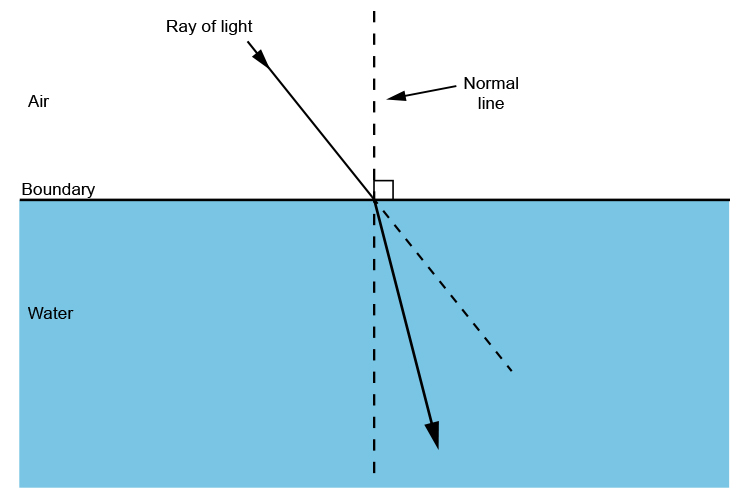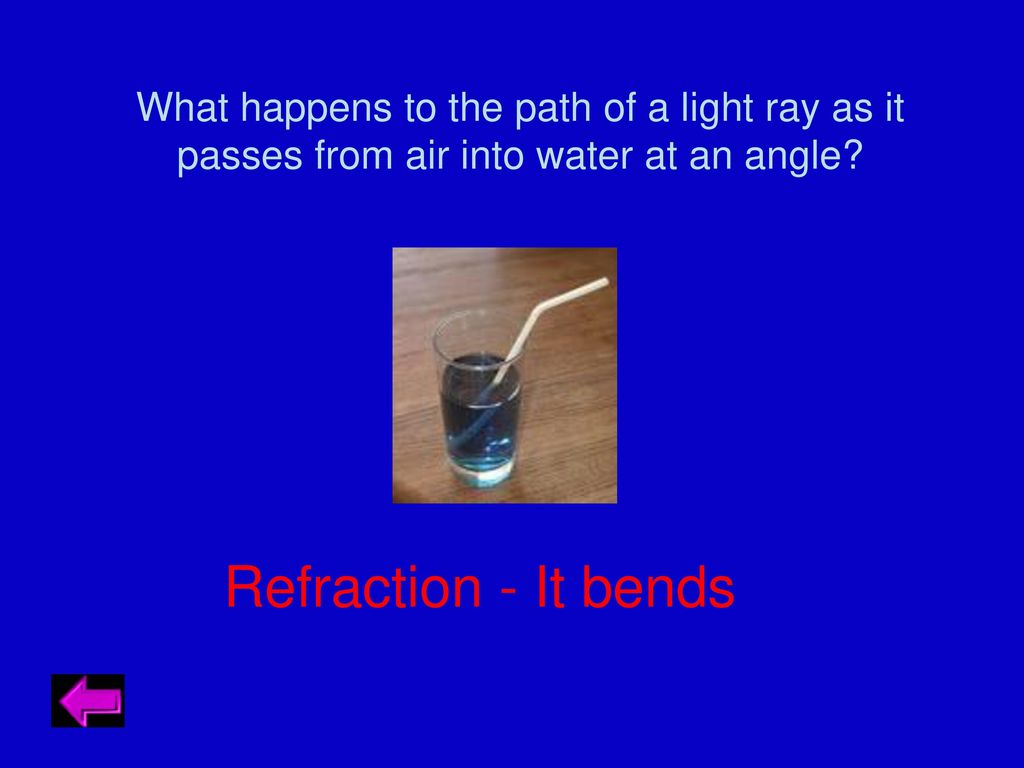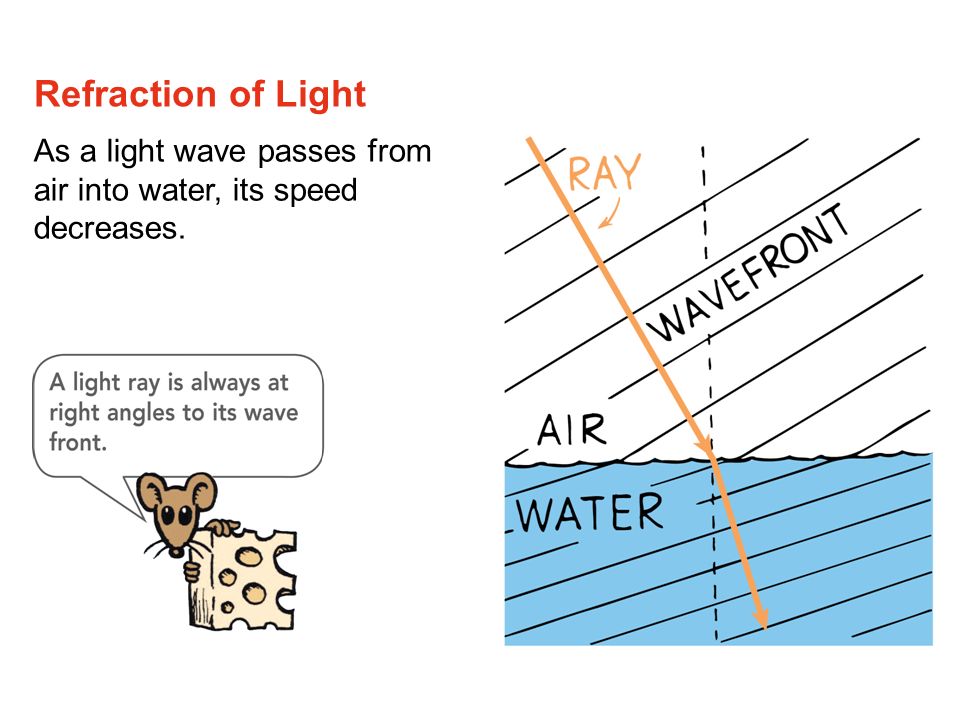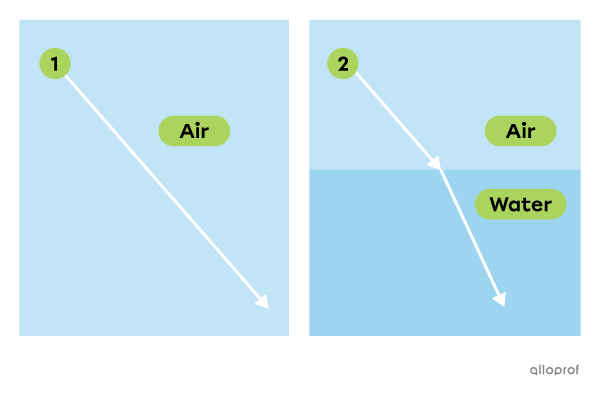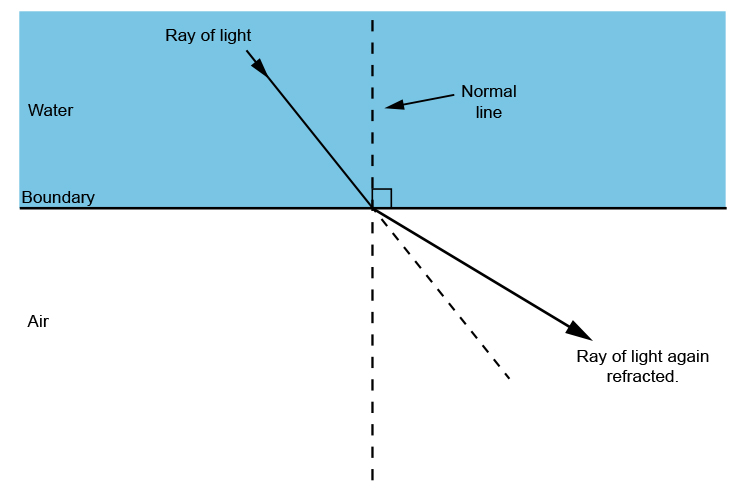What Happens When Light Passes From Air Into Water
+When+light+passes+from+air+into+water+at+an+angle+of+60%EF%82%B0+from+the+normal%2C+what+is+the+angle+of+refraction.jpg)
Imagine standing on a sun-drenched beach, toes sinking into the warm sand. You gaze out at the ocean, the turquoise water shimmering invitingly. The sunlight dances on the surface, creating a dazzling spectacle. But have you ever stopped to wonder what happens to that light as it plunges beneath the waves, transforming the underwater world?
This article explores the fascinating phenomenon of light as it transitions from air into water. We will uncover the secrets of refraction, absorption, and scattering, revealing how these processes shape the colors and visibility we perceive both above and below the surface.
The Dance of Refraction
Light doesn't simply pass straight through when it moves from air to water. Instead, it bends, a phenomenon known as refraction. This bending occurs because light travels at different speeds in different mediums.
Think of it like a marching band moving from pavement to mud. The side of the band hitting the mud first slows down, causing the entire line to pivot. In much the same way, when light enters water (a denser medium than air), it slows down and bends towards the normal, an imaginary line perpendicular to the water's surface.
The amount of bending depends on the angle at which the light strikes the water's surface and the difference in the refractive indices of air and water. This is why objects underwater appear to be in a slightly different position than they actually are, a trick of the light that has fascinated observers for centuries.
Absorption: The Colors That Disappear
While some light is bent, not all of it makes it through the water unscathed. Water molecules actively absorb certain wavelengths of light, a process known as absorption. This absorption is not uniform across the spectrum; different colors are absorbed at different rates.
Red light, with its longer wavelength, is absorbed most readily. As you descend into the depths, red hues gradually fade away, giving way to cooler blues and greens. Orange and yellow follow suit, leaving blue as the dominant color at greater depths.
This selective absorption is why underwater photographs often appear blueish. Divers often use artificial lights to restore the missing colors and reveal the true vibrancy of the underwater environment. According to the National Oceanic and Atmospheric Administration (NOAA), clear ocean water absorbs about 90% of red light within the first few meters.
Scattering: The Murkiness Factor
Even light that isn't absorbed can be affected as it travels through water. Scattering occurs when light bounces off particles suspended in the water, such as sediment, plankton, and other organic matter. This scattering diffuses the light, reducing its intensity and clarity.
The amount of scattering depends on the concentration and size of the particles in the water. Clear, pristine waters have relatively little scattering, allowing light to penetrate deeply. Murky or turbid waters, on the other hand, have high levels of scattering, severely limiting visibility. Coastal waters, often rich in sediment and organic matter, tend to be more turbid than open ocean waters.
Scattering not only affects visibility but also influences the color of the water. In waters with high concentrations of algae, for example, scattering can enhance the green color of the water. This phenomenon is particularly noticeable during algal blooms.
The Interplay of Refraction, Absorption, and Scattering
These three processes – refraction, absorption, and scattering – work together to shape the underwater light environment. Refraction bends the path of light, absorption selectively removes certain colors, and scattering diffuses the remaining light.
The combined effect of these processes creates a unique and dynamic underwater landscape. The colors, visibility, and overall light intensity vary greatly depending on depth, water clarity, and the angle of the sun. In shallow, clear waters, the full spectrum of colors may be visible, creating a vibrant and colorful environment.
However, as you descend into deeper waters, the light becomes increasingly blue and dim, creating a more mysterious and subdued atmosphere. The interplay of these processes is crucial for marine life. It influences photosynthesis, underwater navigation, and even camouflage.
Significance for Marine Life
The way light behaves underwater is not just an interesting scientific curiosity; it is fundamental to the health and functioning of marine ecosystems. Photosynthesis, the process by which plants and algae convert light energy into chemical energy, is the foundation of the marine food web.
The availability of light directly affects the rate of photosynthesis and the distribution of photosynthetic organisms. Areas with sufficient light, known as the photic zone, are teeming with life, supporting a diverse range of plants, algae, and animals. According to a report by the Intergovernmental Panel on Climate Change (IPCC), changes in ocean turbidity due to climate change can significantly impact photosynthetic rates in marine ecosystems.
Many marine animals have evolved specialized adaptations to cope with the underwater light environment. Some animals, such as deep-sea fishes, have developed bioluminescence, the ability to produce their own light, to attract prey, communicate, or find mates.
"The underwater light environment is a critical factor shaping the distribution and behavior of marine organisms," states Dr. Sylvia Earle, a renowned marine biologist and oceanographer.
Other animals have evolved camouflage strategies to blend in with the background light, helping them to avoid predators or ambush prey. Understanding how light behaves underwater is essential for studying marine ecosystems and protecting marine biodiversity.
Human Impact and the Future
Human activities can have a significant impact on the way light behaves in water. Pollution, sedimentation, and nutrient runoff can increase turbidity, reducing light penetration and harming marine ecosystems. Coastal development and deforestation can lead to increased erosion, depositing sediment into coastal waters and reducing water clarity. Excess nutrients from agricultural runoff can fuel algal blooms, further reducing light penetration and creating dead zones.
Climate change is also exacerbating these problems. Rising ocean temperatures can lead to increased stratification, reducing mixing and nutrient availability, which can affect phytoplankton growth and light absorption. Ocean acidification can also affect the growth and survival of marine organisms, indirectly impacting the light environment.
It is crucial to take action to reduce pollution, manage coastal development, and mitigate climate change to protect the health of our oceans and the delicate balance of the underwater light environment. This includes implementing sustainable agricultural practices, reducing plastic pollution, and supporting policies that promote clean energy and reduce greenhouse gas emissions.
A World Transformed
The next time you gaze at the ocean, remember the intricate dance of light as it enters the water. It bends, scatters, and fades, creating a world transformed. Understanding this fascinating phenomenon allows us to appreciate the beauty and complexity of the underwater realm, and to recognize the importance of protecting our oceans for future generations.
The play of light and water is a constant reminder of the interconnectedness of our world, a visual poem written in refractions and hues. So, dive a little deeper, explore a little further, and appreciate the magic that unfolds where light meets water.

